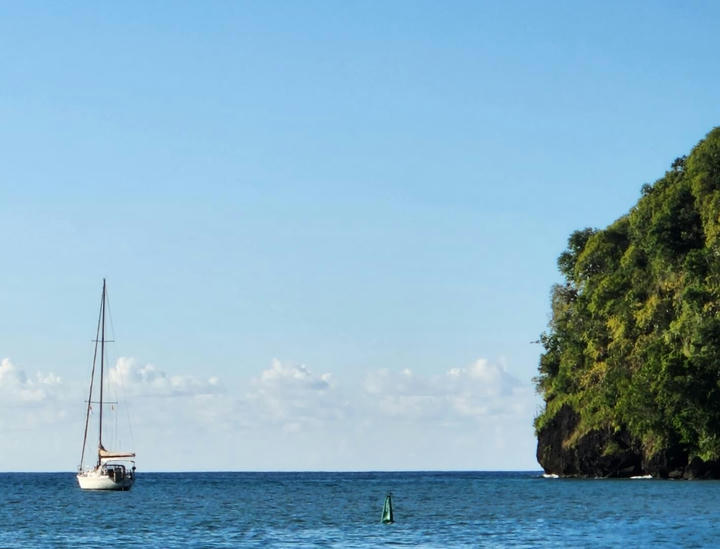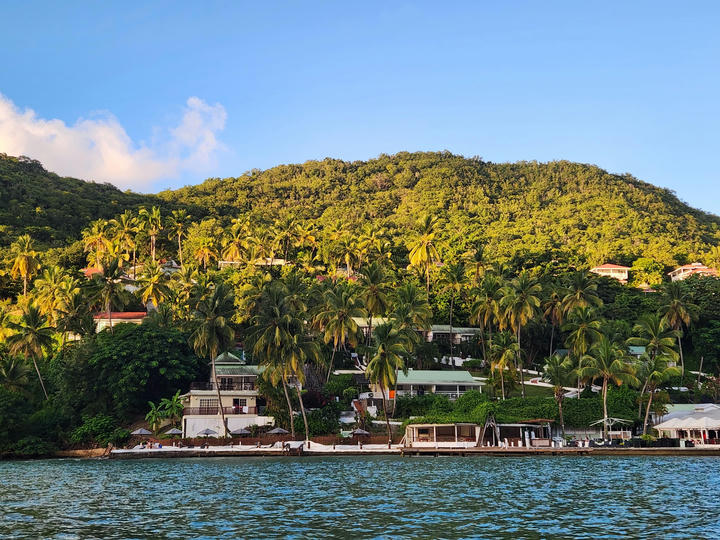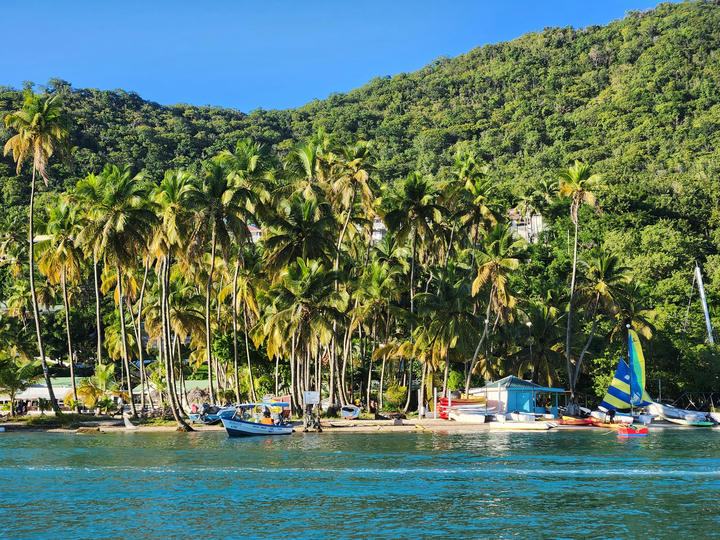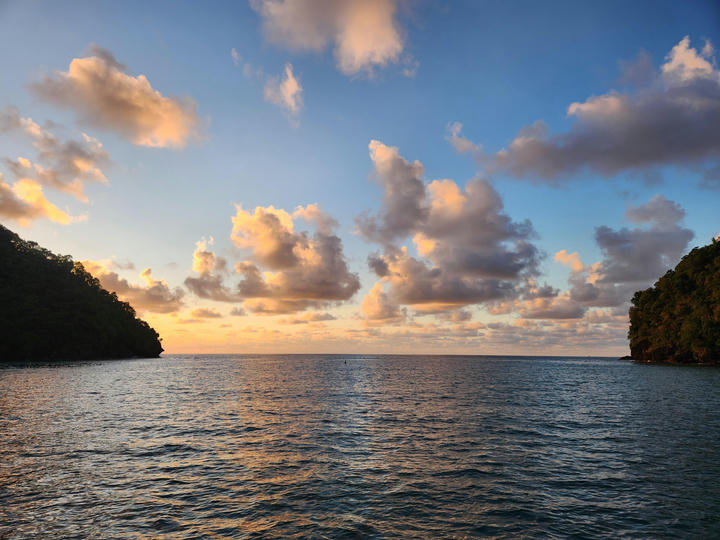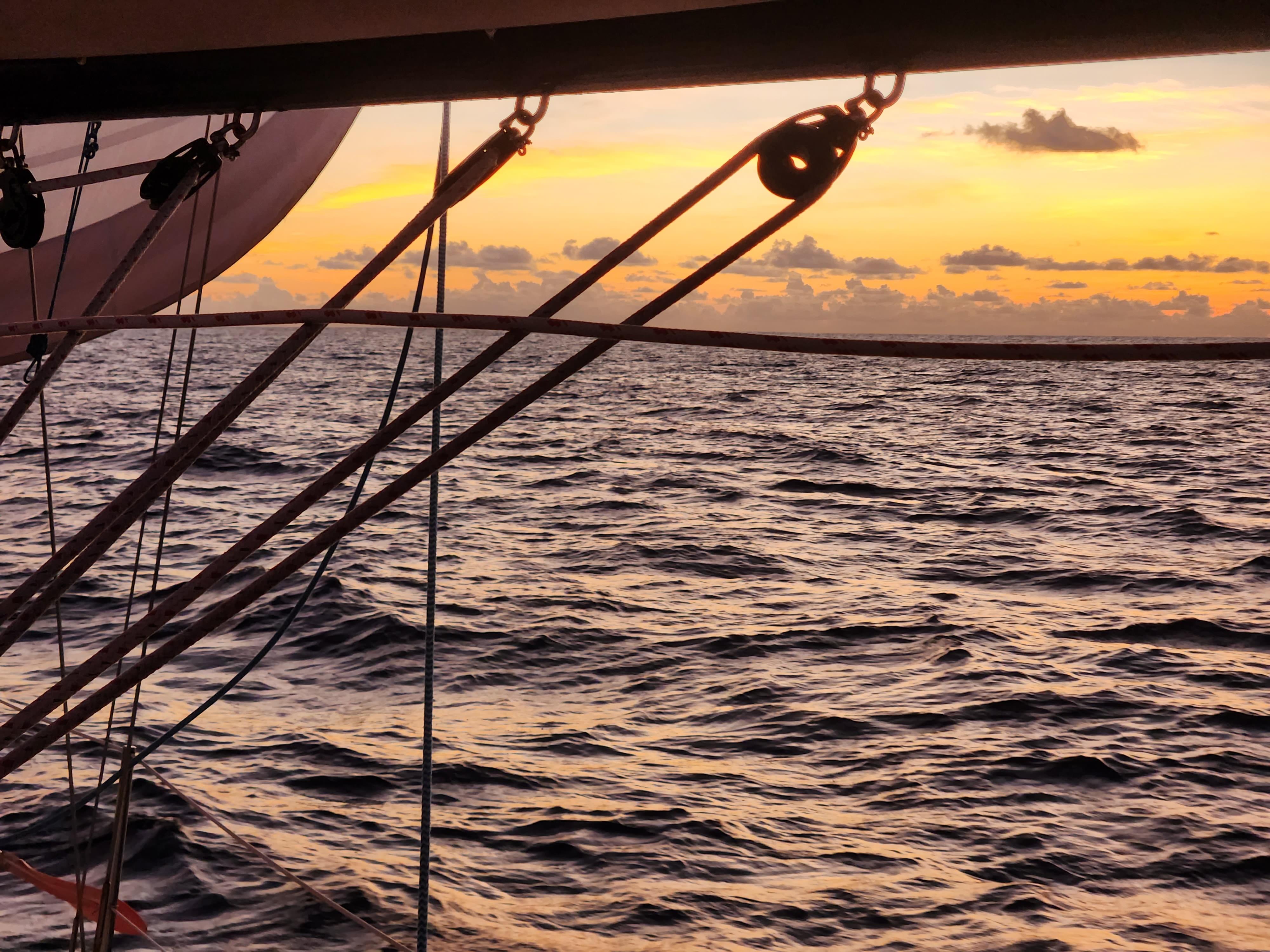With the pressure of Christmas winds approaching, we've started to accept relatively challenging conditions in the forecast as doable. Our tentative to sail towards the British Virgin Islands lost its appeal as the winds looked more and more from the North as opposed to the East. Another factor was also the observation that the winds are slightly stronger in the Northern Caribbean (towards the BVIs) versus the Southern part.
We decided to leave with a forecasted East-Northeast wind, in the 15 to 20 knots range. As the days passed, the forecasted wind was switching to the Northeast, before calming down significantly and veering to the North. The current forecast was also indicating nicely positioned lulls, which meant that if we were lucky, we could get away with not fighting a huge current on the nose the entire time. That is how we pumped one another to leave directly for Saint Lucia, from Bonaire, not a very common trip! We committed to it as I secured an appointment with the French consulate to apply for a visa to visit the French Caribbean islands. We know it was a long shot but getting it in time for spending Christmas in Martinique would be fantastic!
The tentative plan was as follows. The first 3 days were going to be what we started calling "Aruba conditions": pretty uncomfortable beating up at 20 knots true wind. Daytime looked a touch softer (around 16 gusting 20) than nights (more like 18 gusting 24). Daytime also looked more Easterly and the nights had a bigger Northern component, so naturally we planned to be on a starboard tack (heading North) during the day and on a port tack during the night (making Easting). If we managed to make good use of these wind shifts, we could hope to almost tack at 90°angles. After the first 3 days, the winds were shifting to being more Northerly and calming down, an easier sail.
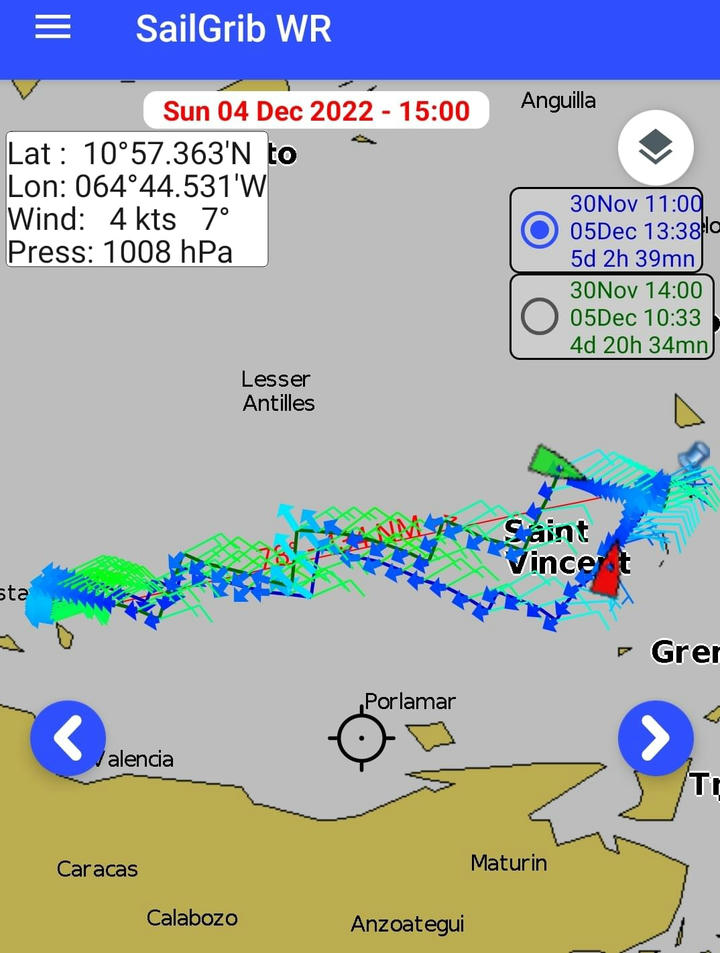
Day 1: Wednesday, November 30th.
We started motoring toward the Southern tip of Bonaire, we wanted to charge our batteries using the alternator. We hit the first setback when we realized the electric autopilot (which we use for steering under engine power) was acting up. The pilot was having a hard time rotating the wheel in one direction, to starboard. Taking advantage of being in the calmer waters in the lee of the island, we checked the steering cables and removed the wheel to check if everything was okay: nothing wrong. We increased the clutch tension but it was still not working as expected. Rain squalls were passing on us one after the other to make things more exciting! We decided to carry on. Marie marked the end of the autopilot investigation by declaring: "As far as I'm concerned, we do not have an electrical autopilot for the rest of the trip". Luckily, we were not planning to motor much with more wind than what we could wish for in the forecast, and Avocet our hydrovane, would steer us under sail power.
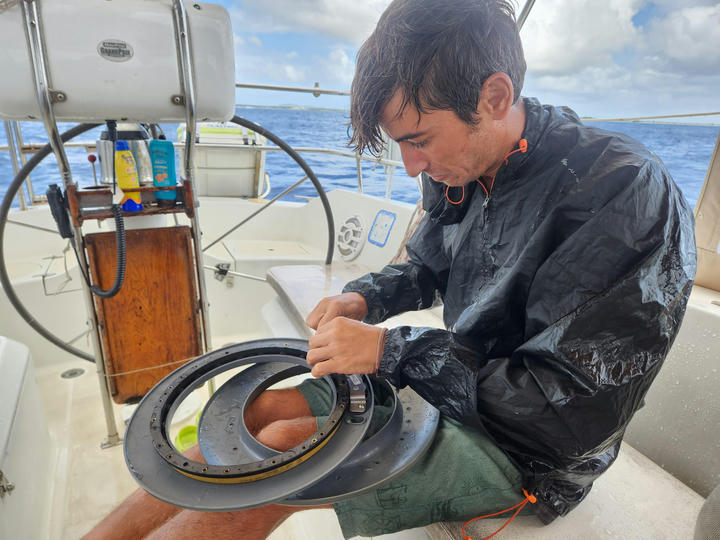
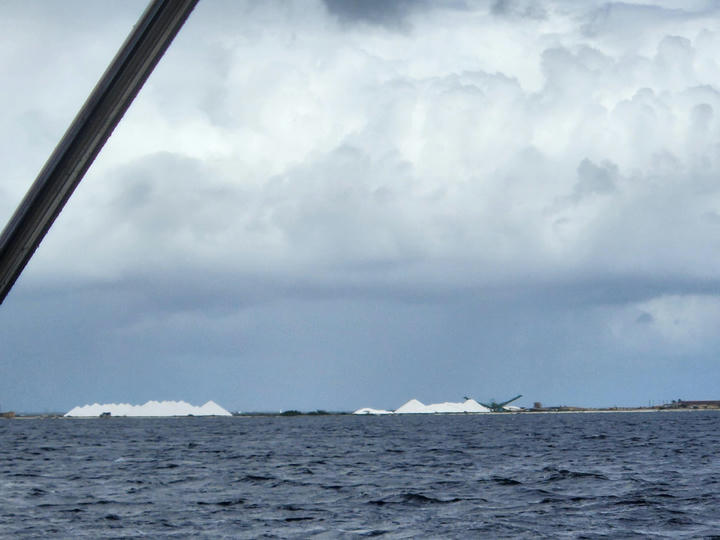
After losing a few hours in the protection of the island, we waited out some rain squalls, had lunch and got going. We had more squalls after rounding the Southern tip of the island, each of them making us reduce the sail area and tuning the wind down after their passage. Progress was slow and the seas were uncomfortable. Current was also particularly strong in this area, so we decided to motor away from the island until clear, to be able to set a port tack towards the East and get on the go finally!
The second setback was the discovery of water in the head. This time we hadn't closed the seacocks and the sink was flooded while we heeled over on the starboard tack. The tools were probably flooded too. We heaved to, let the bilge pump clear the water and closed the sink and all the other tru-holes in the head. I got sick dealing with all that and barfed soon after. I was like a firehose.
We rigged an additional block on the jib furling line to make sure the chafe was not going to be an issue. However, with the violent conditions at the bow, the screw of the shackle had come undone and we had to replace it the next day. Marie spotted this failure on time during her deck check and luckily we did not foul the furling or reefing operation.
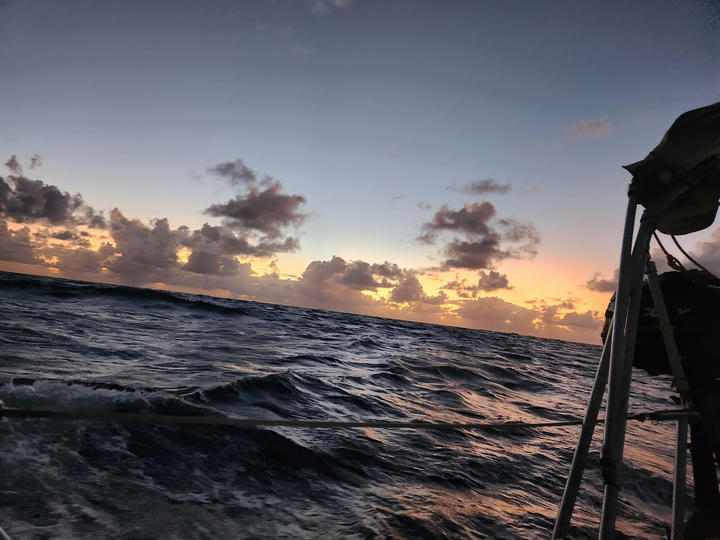
The first 3 days, we were in survival mode: two reefs in the main, jib reefed at night, sometimes unreefed during the day. I was fighting seasickness and the fatigue that comes with it. Marie seemed a bit better, she had used a Scopilamine patch. She also got briefly sick one time and barfed a really small amount.
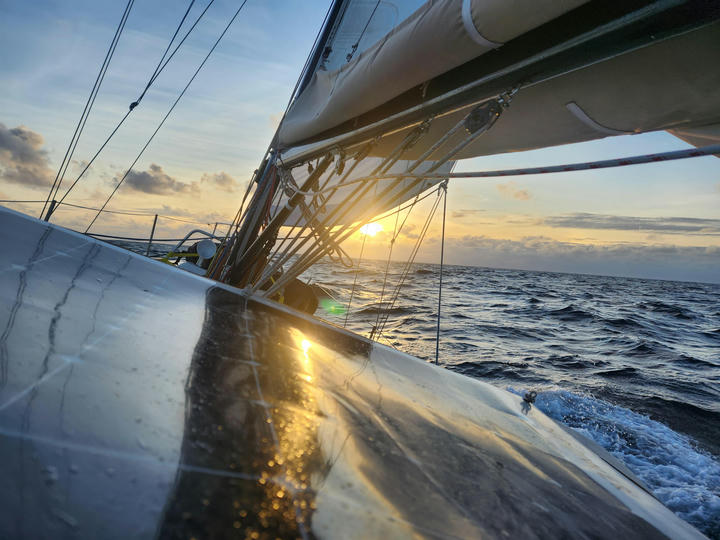
The first day I had no appetite. On the second morning, I enjoyed one of the cheese and ham sandwiches we had prepared beforehand. I also forced myself to have a bit of the potato salad we prepared earlier. On the third day, I wanted a little bit of pasta Bolognese which I served with some yogurt. My appetite was slowly coming back and the fatigue slowly became just a regular physical tiredness. This time it took slightly more than 48 hours for my sea sickness to be tamed. I kept drinking water, even if that meant having to go inside to the bathroom more often. Marie exclusively slept outside for those first three days, staying away from the loud bangs and creaking of the interior cabin, which both increases the worry about the boat holding up together and decreases the quality of sleep.
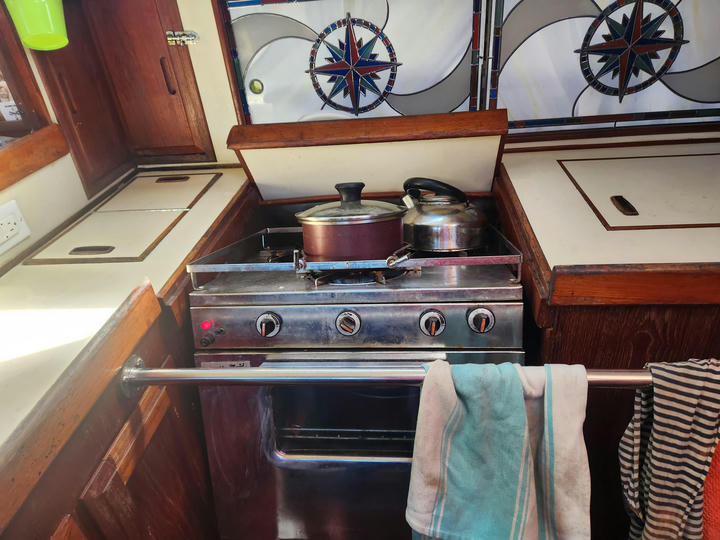
As I said, those 3 days passed in survival mode. The progress was slow as our tacking angles were significantly worse than what the weather routing predicted. Maybe there was slightly more current? We did not eat enough but we slept enough. The nights were relatively uneventful and the person on watch had time to sleep in 20-minute intervals, while the other was sleeping for a few hours at the time. At least, when there were no maneuvers to be done to avoid or reduce sail during squalls, but that was mostly the first night and decreased after that. The moon was getting larger every night and was offering really bright moonlight for the first part of the night. That was appreciated for a smooth transition between day and night.
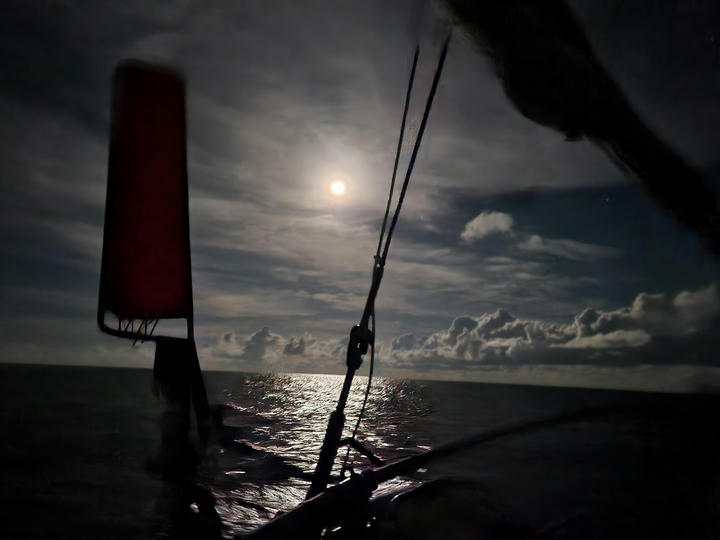
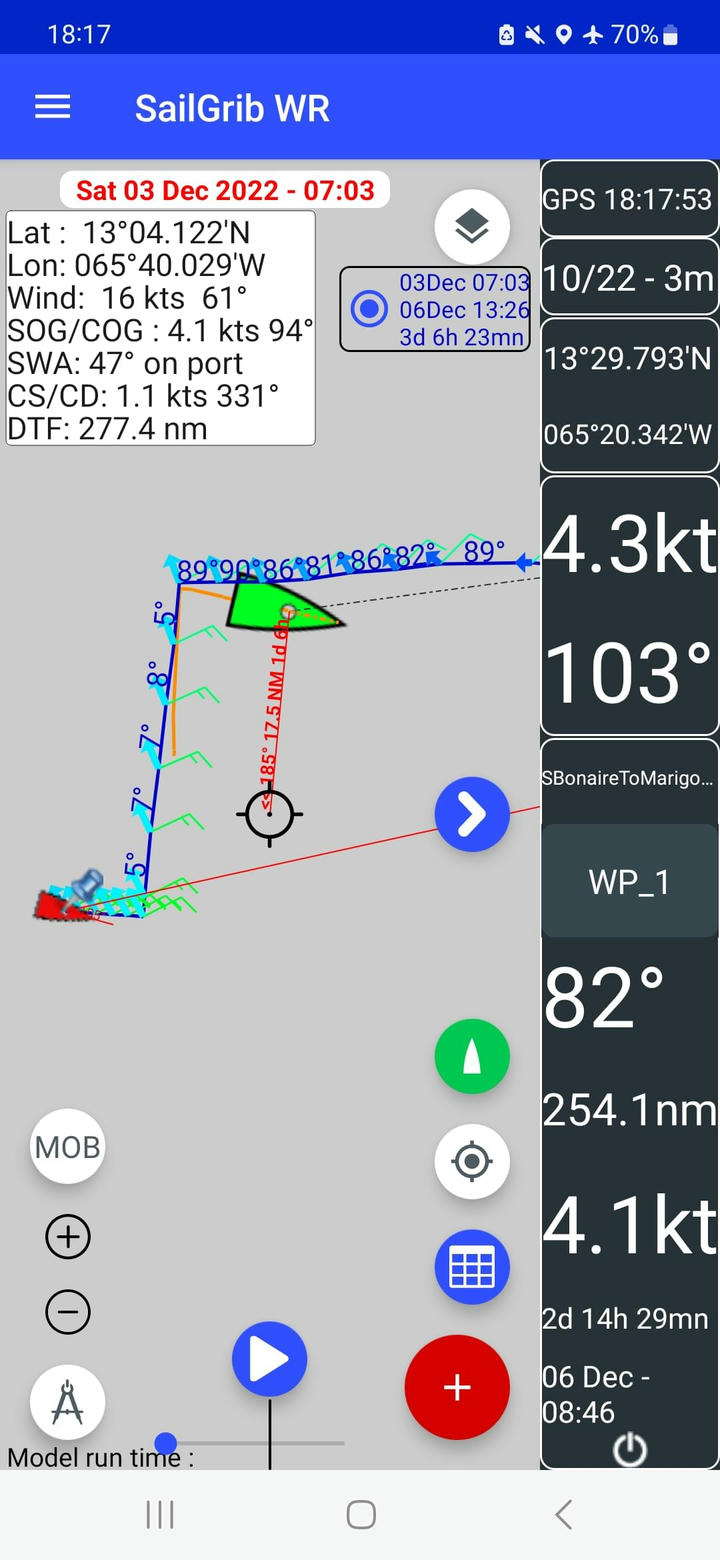
On the second, or maybe the third night, I can't remember exactly, during Marie's shift, she spotted a ship which did not show on AIS. She woke me up and started going through the pirate defense checklist: nav lights off, flare gun handy, old phone out, new phone hidden, boat hook ready to be used defensively, dock lines ready to throw overboard to foul the props. Five minutes later, the ship appeared on AIS... Our VHF antenna seems to be losing its efficiency...
During the day Saturday, we rigged (well mostly Marie) a red blanket as the shade in the cockpit between the wheel and the back edge of the dodger. It made a nice little tent and we enjoyed listening to Matthew McConaughey's audiobook, Greenlight.
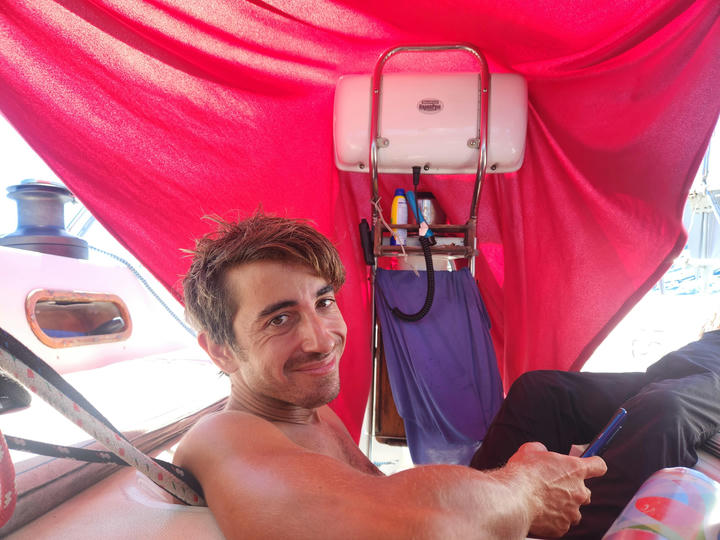
Saturday night into Sunday morning was beautiful sailing conditions, with lower winds and a much more comfortable night. We both rested plentifully and enjoyed smaller waves. Sunday morning, we attended the Escapee SSB net we had joined in Curaçao on 8 MHz and heard from all the usual suspects. They, or at least the hosting boat Zen Again, heard us too.
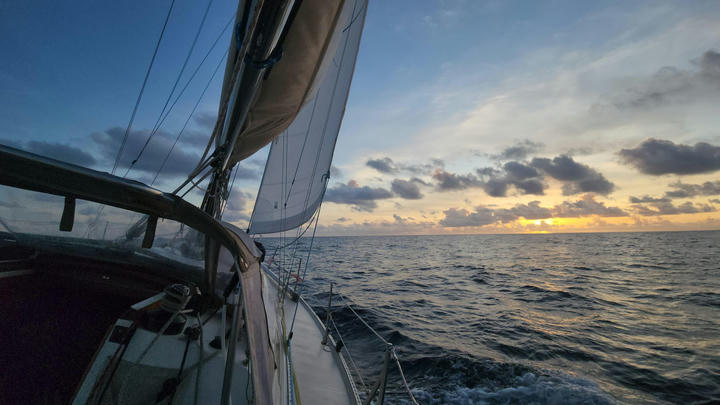
Sunday were the most pleasant conditions we had experienced in the Caribbean Sea: less than 10 knots of wind, not much swell and the boat moving at half the wind speed or more, with winds on our beam. The crew just enjoyed and refilled with energy and motivation. The day before, I was ready to commit to 48 hours of motoring for an arrival in 2 days. Today I don't even want to arrive in 3 days, it's that good. Nobody is around, we saw no other vessels.
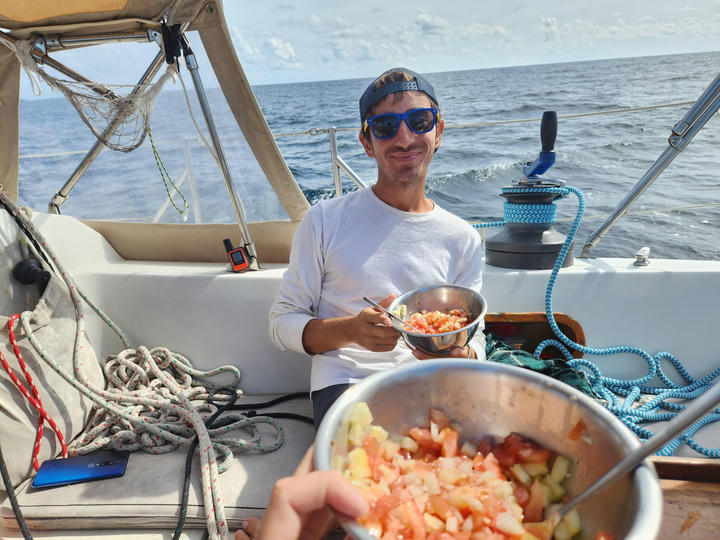
By the way, let me note that we did not manage the battery charge well. We dropped to 15% and had to charge with the engine. We motored for 30 minutes on Sunday morning and 40 minutes in the evening. We are going to have to charge more if we want to keep the fridge running. The 2nd 40-minute engine run only brought us to 30% charge.
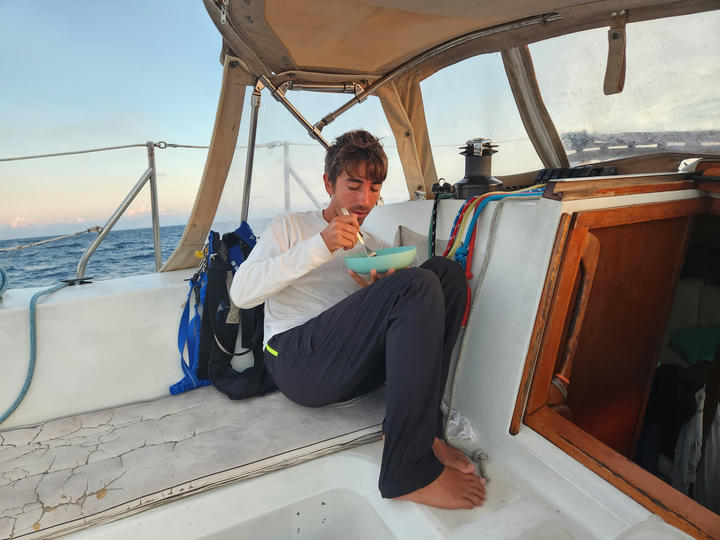
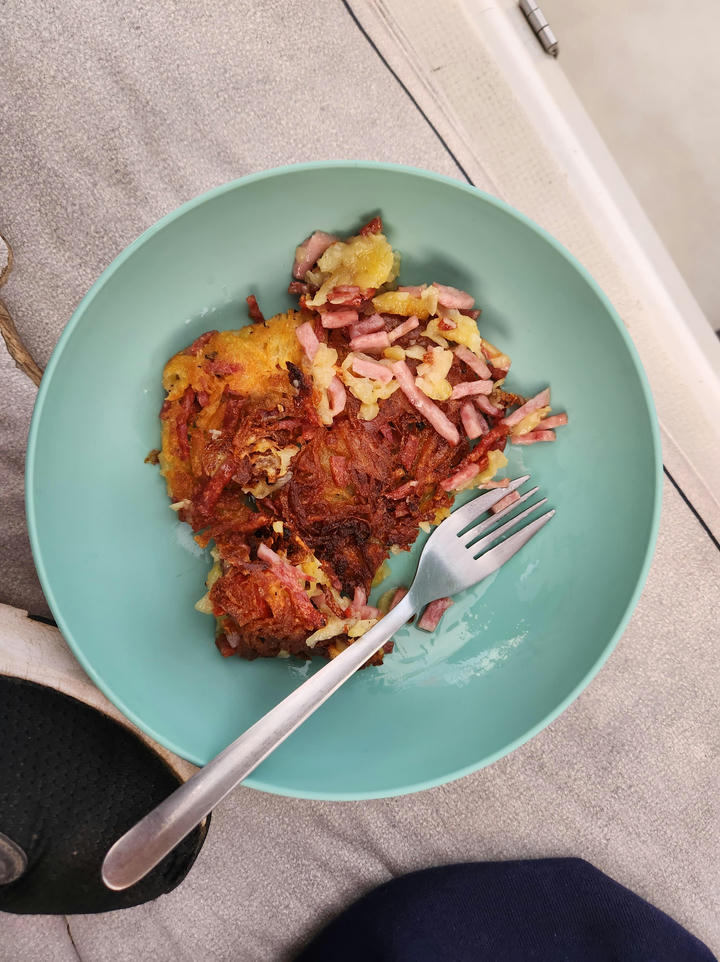
Monday was quite chill, we squeezed in a quick dip and a freshwater rinse. The excitement of the day was a relatively large bright red fishing buoy we spotted at a distance dead ahead. Since it was bright red and very close to the surface, we thought it might even be a lifejacket or a liferaft, but it was just a couple of buoys tied together. We cooked pasta pesto for lunch and Marie made a lentil soup (very tasty!) for dinner. I slept almost the entire night from 22:00 to 4:00.
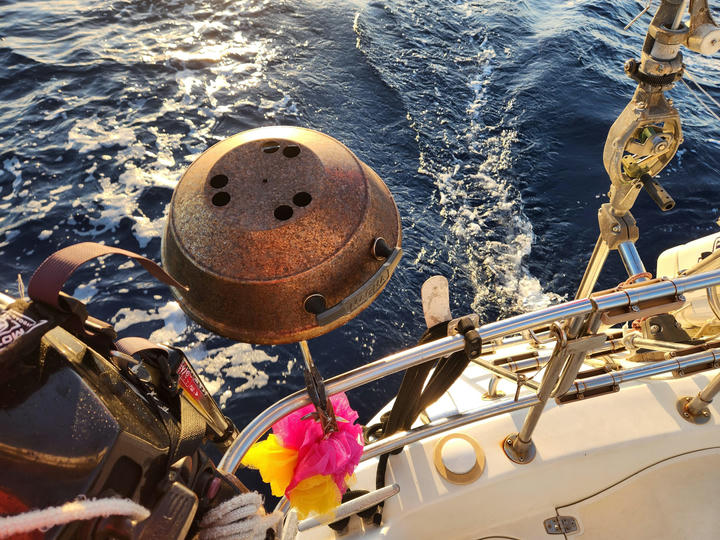
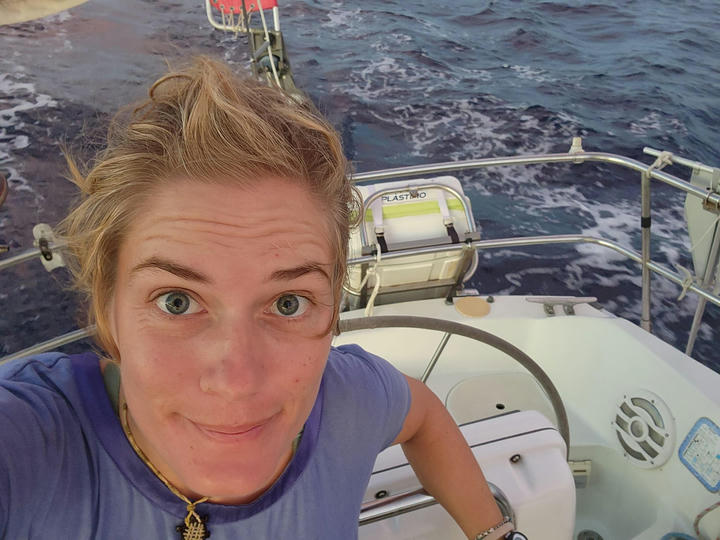
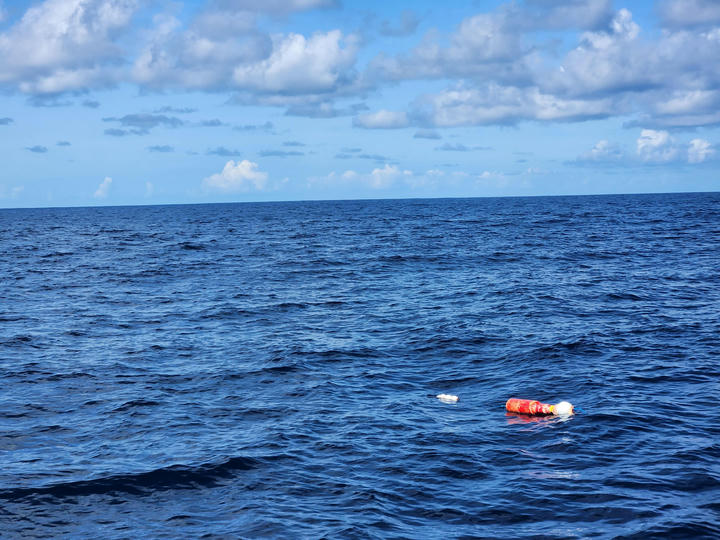
After I took my shift, the autopilot started giving an alarm: "no control head". Given that it was the control head itself giving the alarm, it did not make any sense! I turned the autopilot control on, the pod off and it was okay. I realized the pod instruments were disconnected from the N2000 network, no SOG on the speed dial... There must be a problem with the SeaTalk-SeaTalkNG converter, no big deal for now.
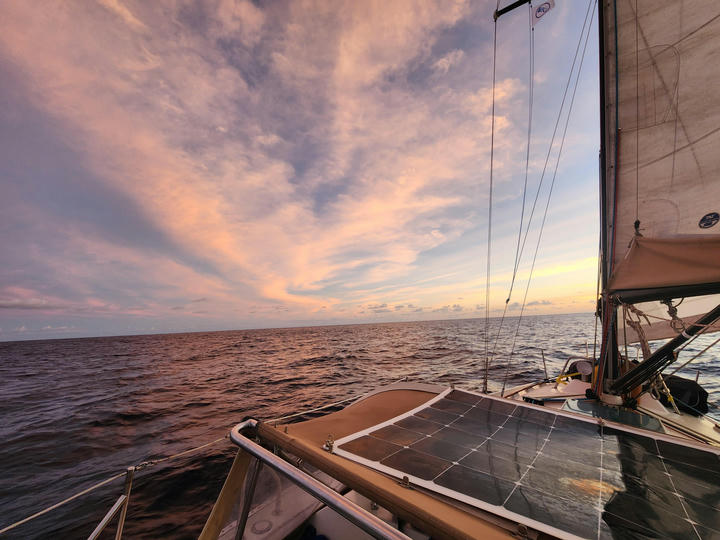
During the day, fishing was very difficult with all the seaweed, they fooled the line every 5 to 10 minutes.
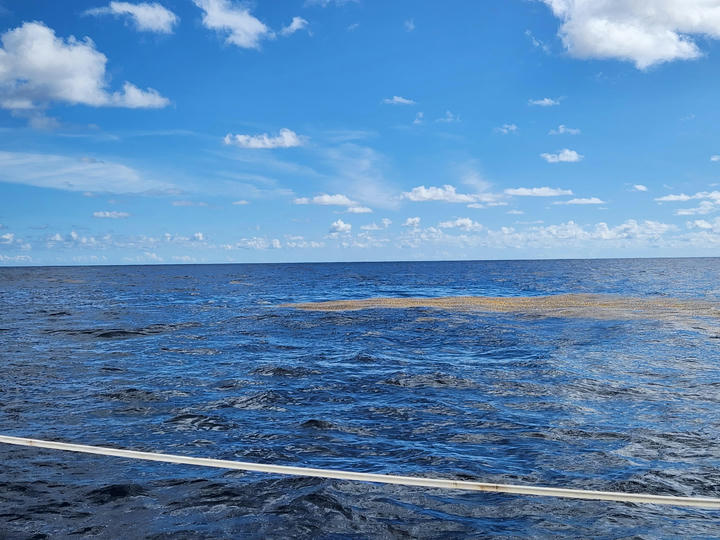
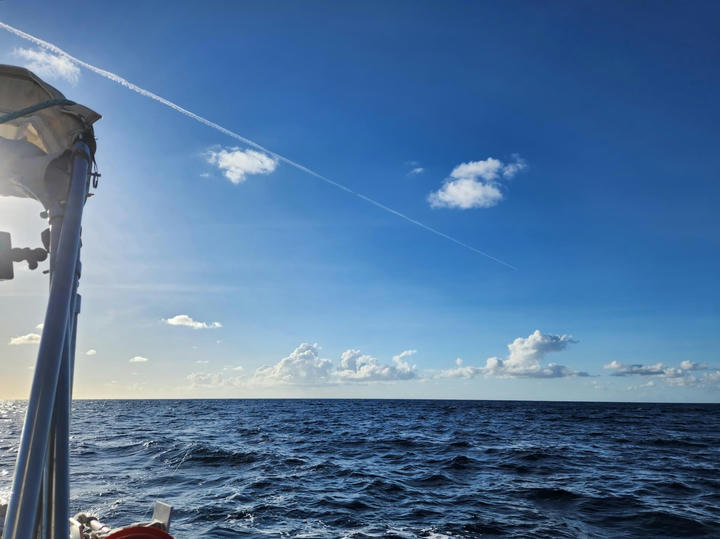
We got updates from our friend and weather contact Ryan 3 times during the trip. First, we asked him if the wind was still dropping down and becoming Northerly on Sunday. He replied that it was, without much additional details. I then wanted to know if we were going to have to beat up again or not. Depending on that, we could try to go more North than we needed to on Sunday/Monday, in order to finish on one single tack. His reply was very detailed and indicated Northeast winds, so we were going to be beating up again. We also got the forecast from the Garmin inReach little sat phone we carry. We got it twice and they were both helpful. It hinted us that Ryan might have mixed East and West in his response, so the forecast was actually Northwest and not Northeast: no more beating up! That's why we carried on directly towards Saint Lucia. Ryan's last message was a moral booster: "Everything looks easy for the finals stretch home!". Thanks mate!
Later we learned that our friends from Curaçao on SV Fin, SV Prism and SV Noorderzon as well as our family and friends had been heavily rooting for us, following our GPS track. It gave us luck and on Tuesday morning (day 7): land oh! The sun rose behind Saint Lucia. It had been pleasant sailing under full rig since Sunday with light winds up to 10-12 knots close/beam reach then broad reach all the way. After sunrise, the wind died down completely and we motored the remaining 26 nautical miles to Marigot Bay, with Martinique island in the North, Saint Vincent in the South and of course, Saint Lucia getting bigger and bigger.
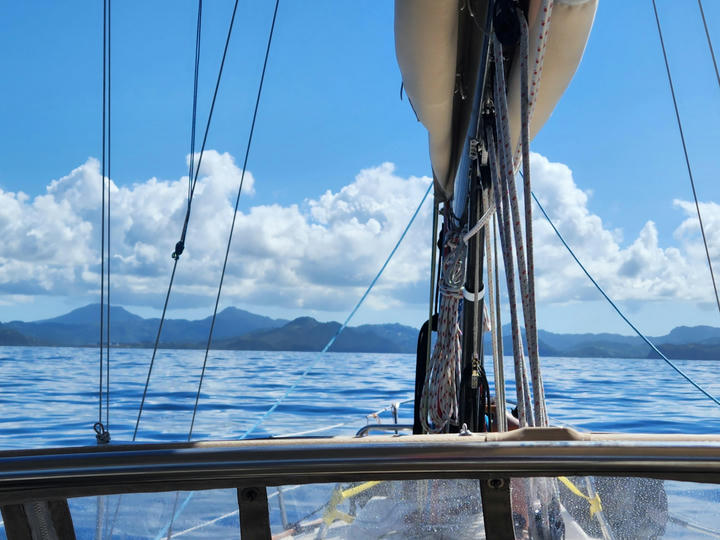
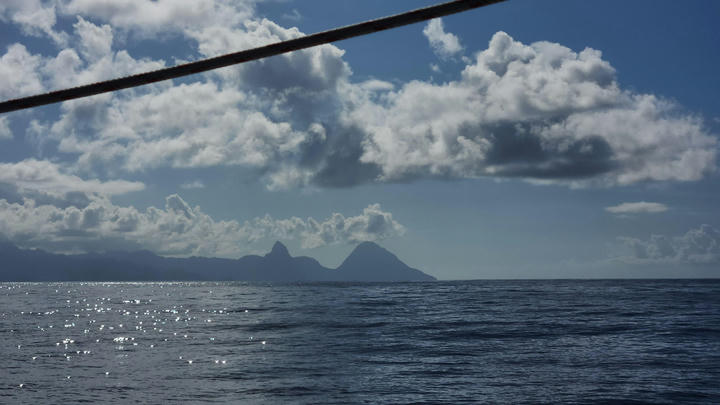
The seas were flat and 10 nautical miles from Marigot Bay, our destination, we got welcomed by the largest pod of dolphins we'd ever seen! They jumped from afar and several dozen rallied our bow. Later more flying fish joined, leaving a trail behind themselves on the water, with boobies trying to catch them and playing with Tire-Bouchon.
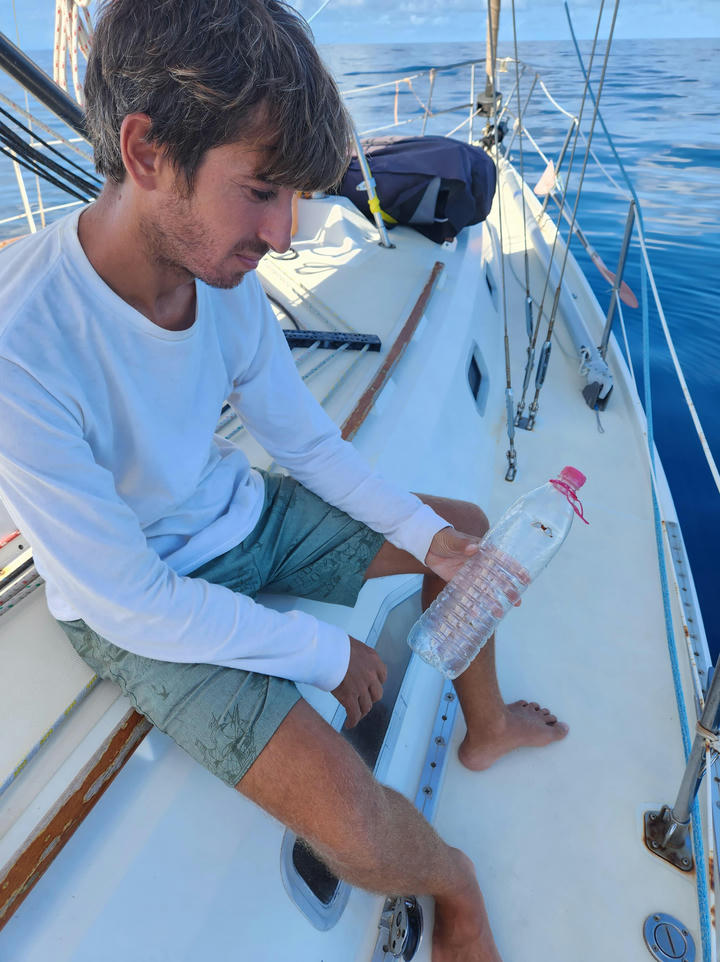
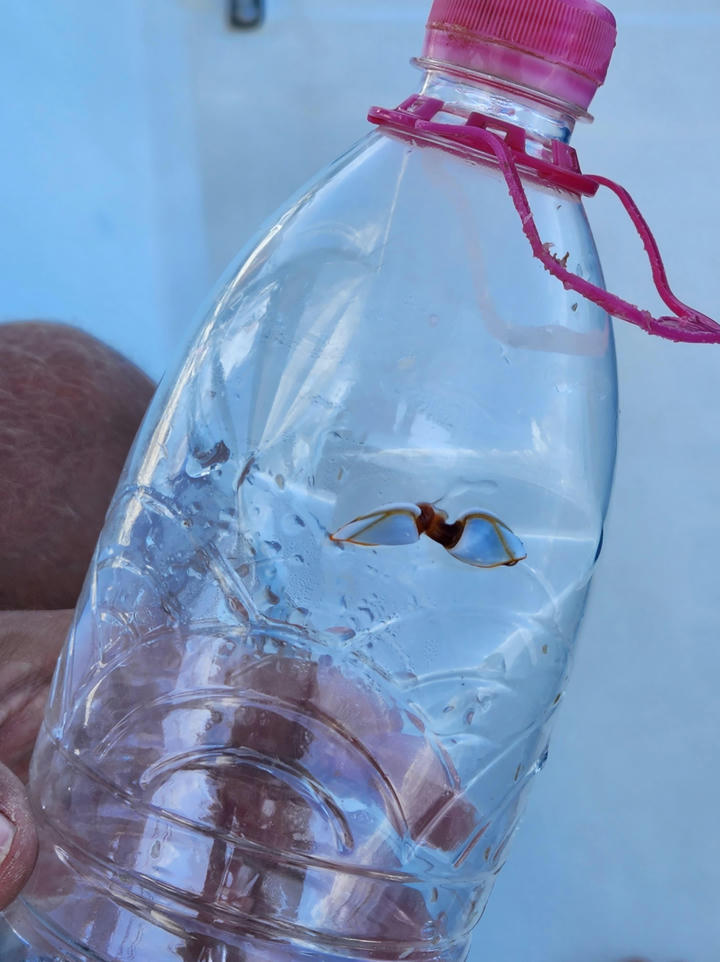
We rescued a plastic bottle overboard, it had a barnacle growing on it! We finished the lentil soup before arriving and I tidied up the boat on the last stretch as Marie handsteered. We dropped the main sail, "our maneuverability joker" right at the entrance of the Bay, which confused the buoy boy who came to meet us on a dinghy to offer help in case we grabbed a mooring ball. Another sailboat was already anchored on the North of the harbor channel - the inner Bay and South of the channel are reserved for moorings. We tried to go East of them to anchor but ran aground (soft grounding, no big deal)!! We really went to Saint-Lucia all the way! We then decided to go in front of them to the West and anchored in 30 feet with the 130 feet of scope to limit our rotation as we were still quite close to the boot and had a show on the North side. As Matthew McConaughey says, 'greenlight'!
